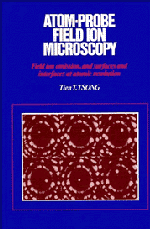 Atom-Probe Field Ion Microscopy
Atom-Probe Field Ion Microscopy Published online by Cambridge University Press: 30 October 2009
The field ion microscope (FIM) was invented by Erwin W. Müller in 1951. By 1957 he was able to show atomically resolved images of surfaces of tungsten and other refractory metals. The FIM is very simple in design and it is hard to imagine that one can image atomic structures of solid surfaces routinely with this instrument. Of course, the simplicity is somewhat deceptive. While atomic images can be routinely obtained for refractory metals with the FIM, to widen its application to other materials has not been easy. It is no wonder that even now, after the FIM has been in existence and in active research for nearly forty years, I am still often asked by scientists outside the field, some of them are very prominent and are also very knowledgeable in science, whether or not FIM can now be used to image materials besides tungsten. The truth of the matter is that the field ion microscope has long been successfully used to study most metals and many alloys, and recently good field ion images of some semiconductors and even ceramic materials, such as high temperature superconductors and graphite, etc., have also been successfully obtained.
The atomic resolution aspect is no longer unique to field ion microscopy. Other microscopies have now also achieved atomic resolution. Some of these microscopes promise to have a great versatility and are currently very actively pursued. On the other hand, there are still some experiments unique to field ion microscopy. An example is the study of the behavior of single atoms and single atomic clusters on well characterized surfaces where quantitative data on various atomic processes can be derived routinely with the field ion microscope.
To save this book to your Kindle, first ensure [email protected] is added to your Approved Personal Document E-mail List under your Personal Document Settings on the Manage Your Content and Devices page of your Amazon account. Then enter the ‘name’ part of your Kindle email address below. Find out more about saving to your Kindle.
Note you can select to save to either the @free.kindle.com or @kindle.com variations. ‘@free.kindle.com’ emails are free but can only be saved to your device when it is connected to wi-fi. ‘@kindle.com’ emails can be delivered even when you are not connected to wi-fi, but note that service fees apply.
Find out more about the Kindle Personal Document Service.
To save content items to your account, please confirm that you agree to abide by our usage policies. If this is the first time you use this feature, you will be asked to authorise Cambridge Core to connect with your account. Find out more about saving content to Dropbox.
To save content items to your account, please confirm that you agree to abide by our usage policies. If this is the first time you use this feature, you will be asked to authorise Cambridge Core to connect with your account. Find out more about saving content to Google Drive.